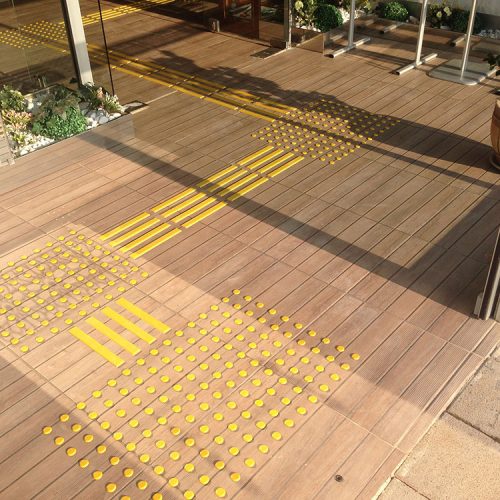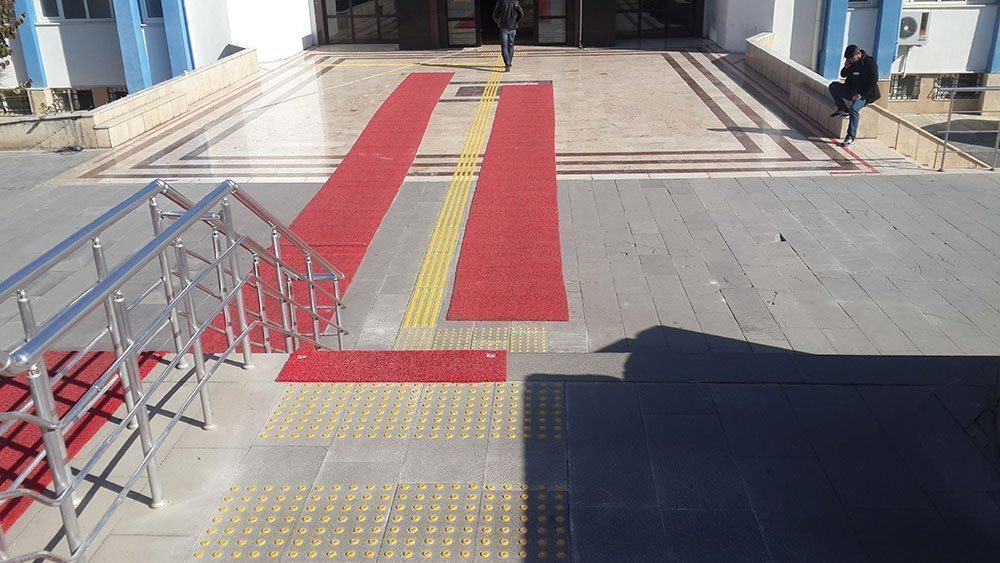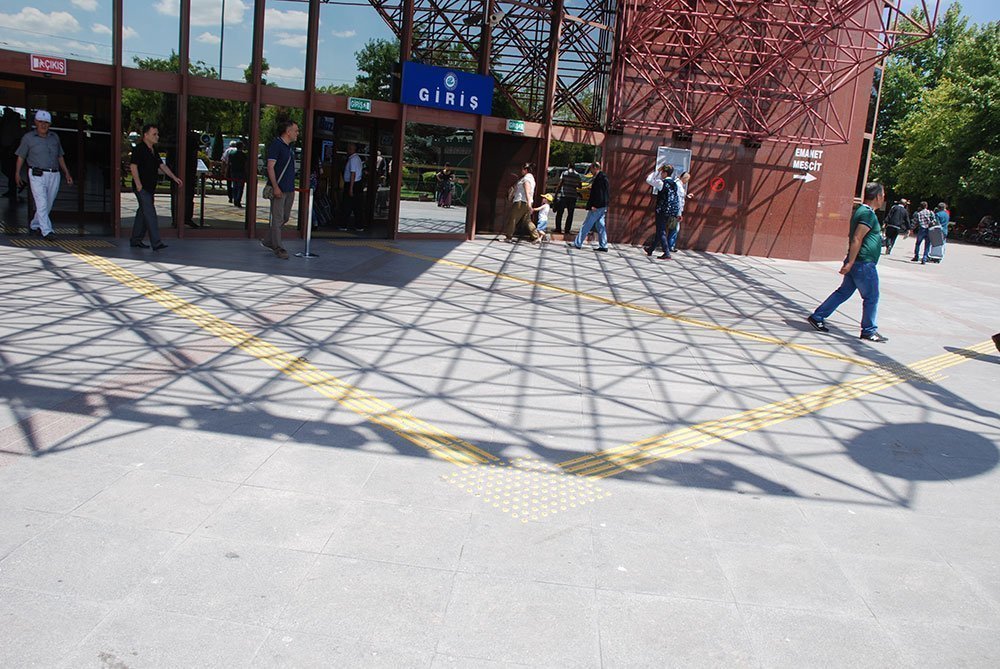Tactile Guide Surface
tactile guide surface; They are surfaces that are embossed in the form of a bar and designed to provide convenience parallel to the direction of movement, and they are strips that will enable visually impaired people to reach their destination safely.
Tactile surfaces are the name given to embossed surface coating products with polymer material, which can be applied in all indoor and outdoor areas, which enable visually impaired people to move more comfortably, safely and alone at the same time.
These surfaces have a different profile from the applied floor, which can be felt with the sole of the shoe and the cane; fiber, glass reinforced, polyester based composite products. Special alloy and ceramic etc. They are surfaces made of products that facilitate the life of visually impaired individuals.
It is designed with the aim of providing convenience to the lives of visually impaired citizens by activating their sense of touch and improving the perception systems of low vision citizens. They are relief surfaces that contrast with the ground.
The reason why it is a mandatory application is the strengthening of the perceptions of visually impaired citizens and the development of their sense of touch. Thanks to this obligation, we help visually impaired individuals and make their lives easier. These surfaces, which have many options, provide warning of the dangers that may be faced by visually impaired citizens. It is applied to enable visually impaired citizens to walk without the need for another person.
This practice, which was first applied in Japan, has become a mandatory practice in many parts of the world. Efforts are still being made to implement it in all required areas.
Features Required for Tactile Surfaces
There are some properties that must be present on the tactile surfaces or their structures. If you wish, let’s give you detailed information by briefly talking about these features.
To enable visually impaired citizens to reach their destinations without any danger.
They should be easily felt.
They should be recognizable from where they are adjacent, thanks to their visual contrast and palpable relief.
They must maintain awareness throughout the period of use.
It should be resistant to ultraviolet rays and its colors should not fade.
It should be in a way that does not disturb other people except visually impaired citizens.
It should be simple and continuous.
It should be produced without harming living things and the environment, should be resistant to weather conditions, and should have a non-slip feature, especially in winter.
The features that we have written above have been made a rule by foreseeing people, animals and vehicles, both disabled and non-disabled. In general, it was also considered whether a person would trip or fall, and research and development studies were carried out to the point of establishing a color rule for individuals with visual impairment but who can see even a little. So where exactly are these products and their derivatives used?
 Uses of Tactile Surfaces
Uses of Tactile Surfaces
The usage areas of these products, which are embossed surfaces that can be easily applied indoors and outdoors for visually impaired citizens; It is used in many indoor and outdoor areas such as pedestrian crossings, subways, stops, airports, sidewalks, fronts of pavement ramps, surrounding urban furniture with disabilities, station surroundings, banks, hospitals, government institutions, mosques, schools, universities, etc.
It is also mandatory for indoor and outdoor use.
Sensible Surface Types
The tactile surfaces are divided into three as the tactile guide surface, the stimulating surface and the elliptical surface. These three surfaces have their own characteristics and meanings.
Tactile Guide Surface
They are surfaces that have been provided with a rod-shaped relief process and have been designed parallel to the direction of movement. The tactile guide surfaces guide the visually impaired citizens to the direction they can go, easily, comfortably and safely.
So what exactly do these guide surface strips do for visually impaired individuals if you would like us to list them?
They serve as a guide for individuals with low vision.
They minimize the possibility of tripping and falling for visually impaired individuals.
It eliminates the risk of injury caused by abruptly ending pavement heights.
Due to its non-slip feature in winter months, it eliminates the risk of slipping and falling in individuals with visual impairment or low vision problems.
It visually adds a different atmosphere to the roads with its color, structure and way of application.
They eliminate the possibility of tripping and falling due to the structure of individuals who do not have vision problems, etc.
If these tactile guide surfaces are to be used indoors, they must be produced on the basis of the principle of non-contamination, in the same way, if they are to be used outdoors, they must be based on the non-slip principle with the serrations on them.
It can also be produced in two colors, it is a matter of preference. perceptible
A guide surface is produced in 0.40*50 and 0.30*50m dimensions. The tactile guide surface should be used in conjunction with the stimulating surfaces. They should warn of the dangers they may encounter along the way and inform them that they have been reached.
The element that needs to be addressed in tangible guide tracks is purely safety. Guide tracks can also be laid organically to ensure safety. There should be no confusing spaces. If there is an obstacle such as a manhole cover around the guide track, it should be provided in such a way that it curves around it, and safety should not be disrupted.
Sensible Stimulating Surfaces
They are surfaces with relief process in the form of dots or domes. They are only designed to warn in a dangerous situation or to draw attention at decision points. The purpose of these surfaces is to make the visually impaired citizen feel any change on the road. For example, pedestrian crossings, sidewalks and ramp fronts can be given as examples.
Tactile Elliptical Surfaces
These surfaces, on the other hand, are surfaces with relief in the form of an ellipse. It is designed to make visually impaired citizens feel the level difference in rail systems, for example in subways, platform and ground crossings.
For questions and problems that remain in your mind despite reading our content, you can find out all you are wondering about the tactile guide surface, which is the content of this article, by calling 0850 441 0 441.






